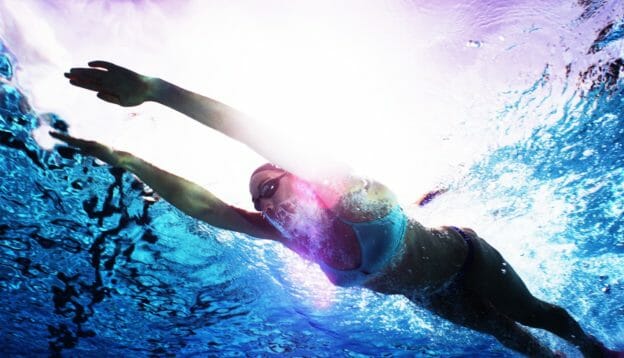When it comes to doing the fastest open turns, another law of physics (besides Newton’s Laws of Motion) comes into play. It is called the Law of Conservation of Energy.
This Law simply states that within an isolated, rotating system (like a swimmer turning on the wall), whatever amount of energy that is generated by the swimmer to make that turn happen will remain constant. The amount of the energy in that system can neither be created nor destroyed.
The amount of kinetic energy in a swimmer turning on the wall is related to the swimmer’s mass, the square of the swimmer’s angular velocity (speed of the swimmer turning around), and the square of the swimmer’s length (diameter of the turning circle).
The mass of the swimmer is fixed, at least for this one turn. Since the last two factors, angular velocity and diameter, are exponentially related to the energy determination, that means changing one will dramatically impact the other. In other words, if we shorten the diameter of the swimmer on the turn just a little, the resultant angular velocity will increase significantly, in order that the energy remains constant.
That is precisely what the swimming technique spin turn does. This technique enables the swimmer to shorten his or her diameter slightly by tucking the knees under the chest more than with the vertical turns of the past. The result is an incredibly quick turn-around.
With the swimming spin turn, rather than elevating upward against the gravitational force, the swimmer remains in a more horizontal position with hips held higher and the head held in a lower position. To make that happen, the swimmer tucks into a tighter ball and turns the head back toward the wall as the body spins around, enabling the mouth to be above water for the breath. No more ‘elbow your brother and phone your mother’, as was taught with the slower vertical turns.
For an excellent tutorial on how to do a spin open turn, hop in Lane 2 or 3 on our subscription service. In this week’s webisode, you will see Olympian Kelsi Worrell Dahlia doing a fast butterfly spin turn and some of the great drills we offer at The Race Club to help teach this fast, open turn technique.
For those that subscribe to Lane 3, this week you will also find a tough static abdominal exercise that was taught to me by one of the fastest Masters swimmers of all time, Rich Abrahams. We hope you will enjoy them.
Yours in swimming,
Gary Sr.
https://theraceclub.com/video/spin-turns/

